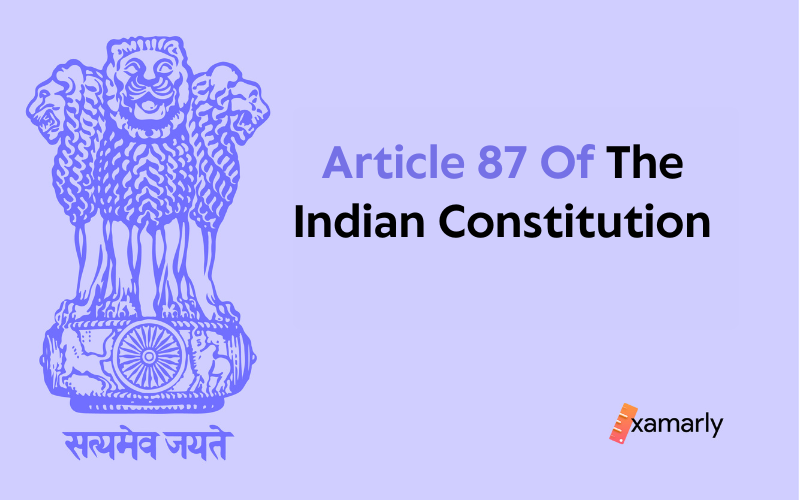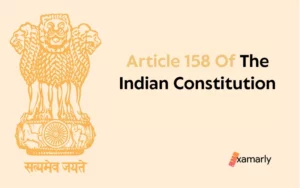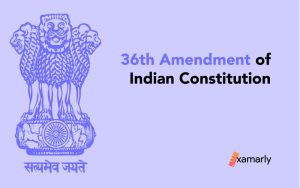The president addresses at both the first session following each general election and the first session of each fiscal year and is pursuant to Article 87 of the Indian Constitution.
The president explains the government’s plans and programs for the year that has just ended and the one that will follow in this address.
In both Houses of Parliament, a motion known as the “Motion of Thanks” is used to discuss the president’s speech, which is equivalent to the “speech from the Throne” in Britain.
According to rule 17 of the Lok Sabha’s Rules of Procedure and Conduct of Business, the consideration of items included in the President’s Address is based on a Motion of Thanks that has been moved and seconded by two members.
In relation to the IAS Exam, this article describes Article 87 of the Indian Constitution.
Article 87 Of The Indian Constitution
The Special address by the President is covered in Article 87 of the Indian Constitution. It stipulates that:
- The President shall address both the Houses of Parliament assembled together at the start of the first session following each general election to the Lok Sabha and at the beginning of the first session of each year. He also informs Parliament of the reasons for its summoning.
- The rules governing the process of either House shall make provision for the allotment of time for debate of the subjects alluded to in such address.
Constitutional Provisions
The President’s special address is allowed under Article 87. The President shall address a combined sitting on two special occasions, according to this provision.
- At the start of the first session following each general election to the House of People and
- At the start of the first session of every calendar year.
- The President is required to explain to Parliament why it has been called.
- This kind of address is known as a “special address,” and it is also a yearly feature.
- Until the President has addressed the two Houses of Parliament gathered together, no more business is conducted.
Regarding Joint Session
This address is intended for both Houses of Parliament when they are gathered together.
However, if the Lok Sabha has been dissolved and is no longer in existence by the start of the year’s first session, the Rajya Sabha must convene. Even without the President’s Address, Rajya Sabha can still convene.
The President addresses both Houses of Parliament when they are both gathered together for the first session following each general election to the Lok Sabha. This occurs after the members have taken and subscribed to the oath or affirmation and the Speaker has been chosen.
What Is The Content Of The President’s Address?
The government prepared the President’s Address because it is a statement of official government policy.
In addition to outlining the policies, projects, and programs the current government desires to pursue in relation to significant national and international concerns, the Address provides an assessment of the government’s accomplishments and actions over the preceding year.
Discussion Regarding The Address By Motion Of Thanks
The “Motion of Thanks” is the motion on which both Houses of Parliament discuss the President’s Address, which is equivalent to the “speech from the Throne” in Britain.
Constitutional Provisions
- Article 87(2) of the Constitution stipulates that rules governing the procedure of either House made the provisions for the allotment of time for discussion of the topics alluded to in the President’s Address.
- According to Rule 15 of the Rules of Procedure and Conduct of Business in the Rajya Sabha, discussion on the topics mentioned in the President’s Address is based on a Motion of Thanks that is moved by one member and seconded by another member.
- The Prime Minister chooses the members who will move and second the motion, and the notice of such a motion is delivered through the Ministry of Parliamentary Affairs.
Procedure
- Members of Parliament have the right to initiate discussions and debates to scrutinize and critique the government and administration for flaws and shortcomings.
- For the consideration of the Motion of Thanks, three days are typically given.
- The Motion of Thanks is adopted in the altered form if any of the proposed revisions are accepted.
- Amendments may make reference to the topics covered in the Address as well as those that, in the member’s judgement, was left out of the Address.
- Amendments to the Motion of Thanks may be proposed in any manner the Speaker deems suitable.
- The motion is put to a vote at the conclusion of the discussion.
Constraints
The only restrictions are that members cannot discuss issues that are not directly under the control of the Central Government and that the President’s name cannot be used during the discussion because the Government, not the President, is in charge of the contents of the Address.
Importance Of Motion Of Thanks
The Motion of Thanks must be approved by the House. Otherwise, it is equivalent to the government’s defeat.
It is one method the Lok Sabha might use to voice its lack of confidence in the government. The additional methods include:
- Refusal of a money bill.
- Passing an adjournment motion or a censure motion.
- The government’s defeat on a critical subject.
- Passing a cut motion.
For Further Readings:
Conclusion
Article 87 of the Indian Constitution deals with the special address made by the President of India. This article is outlined in the second chapter of Part V of the Indian Constitution. The First Amendment of the constitution of India has amended Article 87.
FAQs
Why Is The Motion Of Thanks Considered A Motion Of No Confidence?
The government is defeated and eventually falls if the motion of thanks is not approved. Because of this, the Motion of Thanks is regarded as a no-confidence motion.
What Is A Cut Motion?
A cut motion is a special ability granted to members of the Lok Sabha to resist a demand being addressed in the Finance Bill for a particular allocation by the government as part of the Demand for Grants.
What Is The Special Address With Respect To Article 87 Of The Indian Constitution?
The special address is a statement of the policy of Government which the government itself drafted and the President addresses it. Also, this address has to be approved by the Cabinet. The President highlights the accomplishments and efforts in legislation and policy during the previous year and provides a broad framework of the agenda for the next year.






